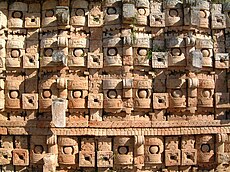Кабах: различия между версиями
| [отпатрулированная версия] | [отпатрулированная версия] |
Нет описания правки |
|||
| Строка 1: | Строка 1: | ||
{{редактирую|1=[[User:Dmitri Lytov|Dmitri Lytov]]|2=14:16, 1 января 2009 (UTC)}} |
{{редактирую|1=[[User:Dmitri Lytov|Dmitri Lytov]]|2=14:16, 1 января 2009 (UTC)}} |
||
[[Image:KabahMasksCatherwood.jpg|thumb|right|230px|Portion of «Temple of the Masks» facade as drawn by [[Frederick Catherwood]].]][[Image:2002.12.29_18_Codz_Poop_Kabah_Yucatan_Mexico.jpg|thumb|230px|right|Codz Poop — Temple of the Masks (Detail)]] |
[[Image:KabahMasksCatherwood.jpg|thumb|right|230px|Portion of «Temple of the Masks» facade as drawn by [[Frederick Catherwood]].]][[Image:2002.12.29_18_Codz_Poop_Kabah_Yucatan_Mexico.jpg|thumb|230px|right|Codz Poop — Temple of the Masks (Detail)]] |
||
Каба, {{lang-es|Kabah, Kabaah, Kabáh, Kahbah, Kaba}} |
Каба, {{lang-es|Kabah, Kabaah, Kabáh, Kahbah, Kaba}} — археологический памятник [[цивилизация майя|цивилизации майя]] на юго-востоке мексиканского штата [[Юкатан]]. |
||
Находится к югу от [[Ухмал]]а, связан с этим городом огромным 18-километровым пешеходным causeway 5 meters wide with monumental arches at each end. Kabah is the second largest ruin of the [[Puuc]] region after Uxmal. |
Находится к югу от [[Ухмал]]а, связан с этим городом огромным 18-километровым пешеходным causeway 5 meters wide with monumental arches at each end. Kabah is the second largest ruin of the [[Puuc]] region after Uxmal. |
||
Версия от 17:12, 1 января 2009
Эту страницу в данный момент активно редактирует участник Dmitri Lytov. |
[[Категория:Википедия:Ошибка выражения: неожидаемый оператор <, редактируемые прямо сейчас]]


Каба, исп. Kabah, Kabaah, Kabáh, Kahbah, Kaba — археологический памятник цивилизации майя на юго-востоке мексиканского штата Юкатан.
Находится к югу от Ухмала, связан с этим городом огромным 18-километровым пешеходным causeway 5 meters wide with monumental arches at each end. Kabah is the second largest ruin of the Puuc region after Uxmal.
Название «Kabah» или «Kabaah», как предполагается, означает на архаичном языке майя «сильная рука». This is a pre-Columbian name for the site, mentioned in Maya chronicles. An alternative name is Kabahaucan or «royal snake in the hand».
Местность была заселена до 3 века до н. э. Большинство сохранившихся до нашего времени архитектурных сооружений было построено between the 7th century and the 11th century. A sculpted date on a doorjamb of one of the buildings gives the date 879, probably around the city’s height. Another inscribed date is one of the latest carved in the Maya Classic style, in 987. Kabaah was abandoned or at least no new ceremonial architecture built for several centuries before the Spanish conquest of Yucatán.
Наиболее известным сооружением в Кабе является «Дворец масок», the façade decorated with hundreds of stone masks of the long-nosed rain god Chaac; it is also known as the Codz Poop, meaning «Rolled Matting», from the pattern of the stone mosaics. This massive repetition of a single set of elements is unusual in Maya art, and here is used to unique effect.

Masks of the rain god abound on other structures throughout the site. Copal incense has been discovered in some of the stone noses of the raingods.
В Кабе также находятся несколько других дворцов, low stone buildings, and step-pyramid temples. While most is in the Puuc Maya style, some show Chenes elements. The site had a number of sculpted panels, lintels, and doorjambs, most of which have been removed to museums elsewhere. The sculptures mostly depict the site’s rulers and scenes of warfare.
Первый подробный отчёт о развалинах опубликовали John Lloyd Stephens and Frederick Catherwood in 1843.
The site is on Mexican highway 261, some 140 km south from Mérida, Yucatán, towards Campeche, Campeche, and is a popular tourism destination. Ruins extend for a considerable distance on both sides of the highway; many of the more distant structures are little visited, and some are still overgrown with forest. на 2003 год, a program is ongoing to clear and restore more buildings, as well as archeological excavations under the direction of archeologist Ramón Carrasco.
Каба была объявлена государственным парком штата Юкатан в 1993 г.
Ссылки
- Kabah on MayaInfo.org with photos
- Kabáh on sci.mus.mn.us more photos
Kabah web site at Reed College. Over 300 19th — 21st century photographs of Kabah. http://academic.reed.edu/uxmal/